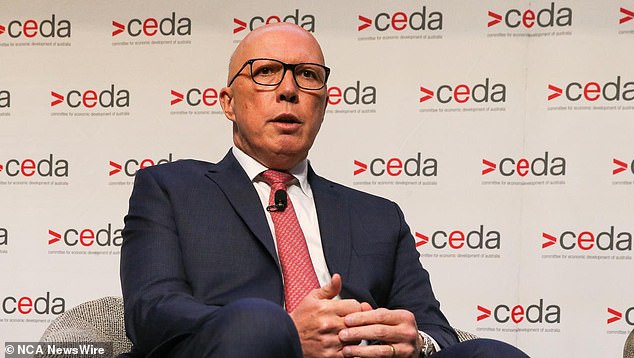Opposition leader Peter Dutton has promised that the coalition’s election pledge to build seven nuclear reactors will cost less than what he says is Labor’s $1.3 trillion renewable energy strategy, but has again declined to give further details on costs.
However, the $1.3 trillion price tag has been questioned by Labor, which says the Australian Energy Market Operator (AEMO) has estimated the construction of the wind and solar generators, plus storage and transmission lines, will cost $121 billion by 2050.
Mr Dutton made the remarks in his address to Australia’s Economic Development Committee on Monday, where he said the Coalition would “publish our costs in due course, at a time of our choosing”.
However, he said he would be “transparent about the locations of our nuclear facilities, we will be transparent about the cost of nuclear power” and that it would be calculated independently.
He added that the 80-year lifespan of a nuclear reactor would be cheaper than solar and wind projects that would have to be replaced every 25 to 40 years.
The oldest nuclear power plant still in operation, the Beznau nuclear power plant in Switzerland, is 55 years old.
“Yes, our nuclear plan has a significant upfront cost, but there will be no need for extensive new transmission networks or infrastructure. In addition, the cost of our nuclear plants can be amortized and spread over the 80-year life of a reactor,” Dutton said.
Peter Dutton Nuclear Power
‘Under the Labour plan, which only focuses on renewable energy, every solar panel and wind turbine will have to be replaced three or four times in the same period.’
Dutton also said adopting nuclear power was Australia’s only chance of meeting its net-zero emissions target by 2050, which would require a mix of energy sources.
Australia’s energy mix is currently about 40 per cent renewables and the goal is to increase this to 82 per cent by 2030.
He also ruled out capping renewable energy contributions to Australia’s power grid.
“I think what we want to achieve is an outcome where we have the right mix and we take into account the price,” he said.
Dutton voices support for gas and attacks renewables
Mr Dutton also acknowledged it would take time for Australia to move towards nuclear power, and highlighted the Coalition’s support for increasing the country’s domestic gas production.
“We cannot turn on nuclear power tomorrow, even if the ban were lifted overnight,” he said.
“Like other countries, we need to increase our domestic gas production in the most immediate term to reduce energy prices and restore stability to our grid, but what we can also do is ensure Australia doesn’t miss the nuclear train.”
Dutton said Australia needed to rely on “domestic gas production in the most immediate term” despite his unpopularity with the Green and Green parties.
“There is a need for more gas, and we have been very clear about our desire to improve approval processes while remaining environmentally responsible and getting more of these projects done more quickly,” he said.
During his speech, Mr Dutton attacked a renewables-only approach which he said would be “disastrous” and “doomed to failure”.
He said an “energy policy based solely on renewables” was “an act of economic self-destruction” and argued that Australia should generate its energy in Australia.
He cited energy bills in California, where residents paid “the highest residential electricity prices in the United States” even though solar and wind power account for more than 49 percent of their energy mix.
Mr Dutton also said that “climate-dependent energy cannot power a nation”, adding that nuclear power would produce more energy with less land.
His comments come amid backlash from farmers and regional communities who say transmission line developments have driven down land values.
“In other words, the nuclear plant produces the same energy using less than 1 percent of the land needed for solar energy,” he explained.
‘With nuclear power, there is no need to cover our landscape and coastline with industrial-scale solar and wind farms or the 28,000 kilometres of new transmission lines needed to make them work.’

